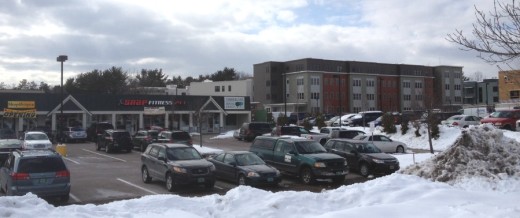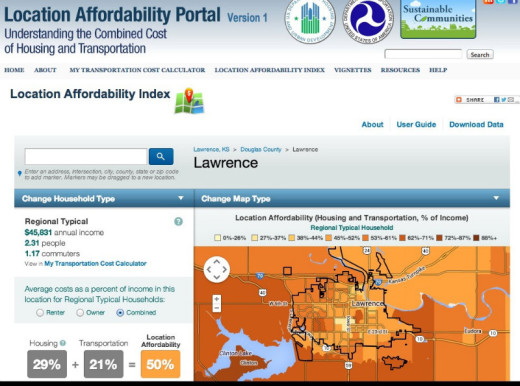with a response from Stuart Andreason
We all have a list of criteria when we look for our first home — be it a rental or owned. Is it affordable, how close am I to my job, are there good schools, is the neighborhood safe, are there parks nearby, what does the community have to offer?

The same is true when we get older in life, but the list of criteria change somewhat. Affordability, safety, community offerings, and amenities are still important. But new criteria enter the mix: how can I get around if I outlive my driving years, am I close to health care and other supportive services, does my home fit my needs?
Location is important to all of us at all life stages, but becomes even more important as we get older and — either through choice or necessity — need more options to connect and stay engaged in the community.
The following are some strategies planning commissioners can consider to provide an appropriate set of housing options in the right locations for older adults.
Coordinate Housing and Transportation Plans
In my hometown of Burlington, Vermont, a proposed independent senior housing development was scuttled in part because it would be located a half-mile from the nearest bus route. Shortly thereafter a proposed development in the same neighborhood, directly on the bus route and next to a shopping center, was approved with minimal opposition.

 We can choose to build senior housing where land is cheap but when solving one problem, we create another one for transportation. I can imagine that had the first Burlington housing proposal been approved (far from the existing bus route), residents would have demanded bus service to the new development, stressing already limited public transportation resources.
We can choose to build senior housing where land is cheap but when solving one problem, we create another one for transportation. I can imagine that had the first Burlington housing proposal been approved (far from the existing bus route), residents would have demanded bus service to the new development, stressing already limited public transportation resources.
It is up to planners to link the location of housing with the location of existing or planned transportation options.
The first thing to do is stop adding to the problem by allowing new development that leaves people stranded.
The next step is to assess the current assets of your community, look for opportunities to make better use of what you have and find ways to link housing and transportation. Many communities are using strategies such as Transit-Oriented Development and rezoning for mixed-use development. These are particularly potent options in suburban settings where the need to retrofit is greatest.
We all perceive suburbs to be places dominated by families with children. However, it’s important to note that more than one half of 65+ households live in the suburbs or smaller towns. 1 Good examples of suburban transformations abound from Arlington, Virginia 2 to Lakewood, Colorado 3 to the Northgate Mall in Seattle. 4
Home Design
New or existing housing stock can be put to better use to support aging. One strategy is to allow for accessory dwelling units (often called “granny flats”). In this case, communities can zone to allow families to add an apartment to their existing home to support an aging relative. This solution helps address affordability, as well as the need for transportation and supportive services. It also provides important family companionship and connection.
Another strategy is to require or provide incentives for new housing development to include universal design elements. Universal design (sometimes called inclusive design) policies ensure homes or apartments include features that provide an environment for people of all abilities.
A related concept is “visitability,” in which the home includes elements that allow for visitors with disabilities. Requiring that government-subsidized housing include universal design elements is a good first step. Private development can also be included. For example, building codes can be changed to require incorporation of universal design elements. Or developers can be offered tax incentives or greater density allowances to include these features.
Finally, communities can establish programs to help homeowners pay for home modifications that will improve safety and accessibility. This is likely outside the domain of the planning commission, but it is important to consider as part of a larger strategy to improve the housing stock to support aging.
Don’t Forget Affordability
Having affordable options in the mix is critical for many older residents. According to the Center for Housing Policy, “older adults are more likely than younger adults to spend more than half their income on housing.” 5 Interventions that make downtowns and areas near transit more attractive have the potential for increasing the value of land and property — and pricing out residents who need access to these amenities. It’s important to have an eye on the unintended consequences of good community planning and ensure all residents are benefitting.
Jennifer Wallace-Brodeur has been at AARP since 2005, serving as Associate State Director in the Vermont State Office until 2013, and then moving to the national office as Senior Advisor States. In Vermont, she led the Burlington Livable Community Project, which established a vision and action steps for Burlington to meet the needs of its aging population. This was one of AARP’s first local livable community projects. She also led AARP’s campaign to pass Complete Streets legislation in 2011, which earned her the Outstanding Service Award from the Vermont Planners Association.
Jennifer is active as a community volunteer, currently serving on the Burlington Planning Commission and previously as chair of the Burlington Electric Commission. In 2012, she was appointed to the Governor’s Commission on Successful Aging and served as chair of the livable communities subcommittee.
A Response from Stuart Andreason:
Housing choices, as Jennifer notes, are often related to “location, location, location” (and to unit type, design, and price)! Planners, planning commissioners, and homebuyers have long understood the tradeoffs between location, home size, home price, and transportation costs, but have often had to rely on intuition or individual knowledge to weigh those tradeoffs. With the recent volatility of gas prices and recession understanding the tradeoffs more clearly is ever more important and new online tools and data can help.
Millennials are less tolerant of long commutes and are delaying car purchases as well. Realtors say that young adults are more conscious of how accessible their home is to work and recreation because they want to use multiple modes to get places. 6
Looking to the (un)employment issues that millenials face (covered on PlannersWeb last month), the age group is making tough decisions on where to live and how to commute to save money and cut costs wherever they can. Estimates suggest that housing and transportation costs account for between 45 and 50 percent of a household’s monthly expenditures and millenials seem to have decided that if they have to cut corners it will be by going multi-modal, living closer to work, sharing a room, and delaying house and car purchases. 7
 The newly released Location Affordability Index (LAI) is part of the Location Affordability Portal 8 The LAI displays estimates of combined housing and transportation costs at the neighborhood level. It is calculated using a range of data sources describing characteristics of neighborhood demographics, the built environment, and transit and job access and covers 94% of the U.S. population.
The newly released Location Affordability Index (LAI) is part of the Location Affordability Portal 8 The LAI displays estimates of combined housing and transportation costs at the neighborhood level. It is calculated using a range of data sources describing characteristics of neighborhood demographics, the built environment, and transit and job access and covers 94% of the U.S. population.
The LAI provides downloadable data for eight different household profiles. For example, it provides a different travel and housing cost estimate for retirees than for young workers. The LAI does this by considering (and estimating) what each of these “resident profiles” might earn, how they might travel, and where they work among other considerations.

Planning commissions can use this information and data when they make decisions about whether a site is right for senior housing (or any other housing development). It can help commissions better understand the complete cost of living in a certain development and how costly it is to travel from that location.
The data won’t solve some of the other issues though — it doesn’t explicitly identify how far developments are from public transportation stops, what types of units are being built, or if the housing has universal design standards. Those are important issues that planning commissions will still have to research, investigate, and discuss with developers.
Millenials face economic challenges that have them considering the affordability of both transportation and housing, but ultimately things will take off for the group. Beyond a weak economy, millenials may also represent a generational shift — the group simply wants to live closer in, near shops, recreation, and work. Only time will tell, but certainly it behooves planers and planning commissioners to consider whether the projects they evaluate are meeting these potential future trends and making the community an attractive location across generations.
Stuart Andreason is a doctoral candidate in the Department of City and Regional Planning at the University of Pennsylvania where he studies community and economic development. He previously researched civic innovation in community participation.
Prior to entering graduate school, Stuart worked as the Executive Director of a Main Street Organization, the Orange Downtown Alliance, in Orange, Virginia.
Notes:
- Housing an Aging Population: Are We Prepared? (Center for Housing Policy, 2012), p. 14 ↩
- Encouraging Transit Oriented Development: Case Studies that Work (U.S. EPA, et al). ↩
- “Belmar: ‘Urbanizing’ a Suburban Colorado Mall” (ULI’s UrbanLand, July 25, 2013). ↩
- “New Lives for ‘Dead’ Suburban Malls” (New York Times, Jan. 21, 2011). ↩
- Ibid. Housing an Aging Population: Are We Prepared? p. 1 ↩
- See G.M. Filisko, “How Millenials Move: The Carless Trends” (National Ass’n of Realtors, Aug. 2, 2012) and “APTA Reports 70% of Millenials go Multimodal (Metro Magazine, October 1, 2013) ↩
- See Derek Thompson and Jordan Weissmann, “The Cheapest Generation” (The Atlantic, Aug. 22, 2012). ↩
- U.S. HUD and DOT Location Affordability Portal 9 developed by the U.S. Department of Housing and Urban Development and the Department of Transportation. 10Another alternative is the Housing and Transportation Index (H+T) from the Center for Neighborhood Technology. Like the LAI, the H+T estimates the costs of travel and housing across neighborhoods, cities, and regions. ↩